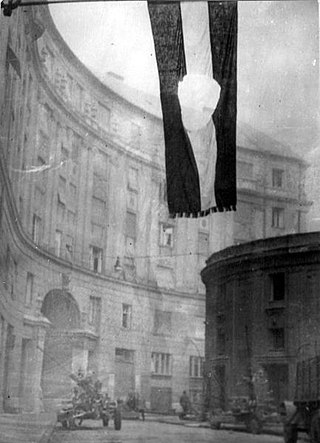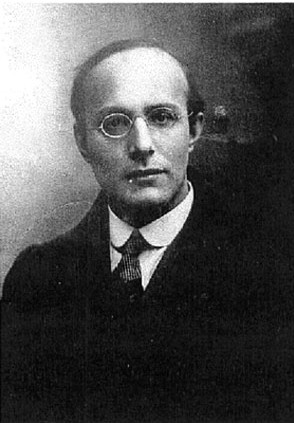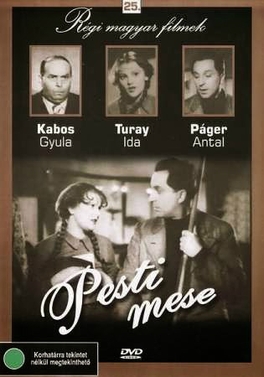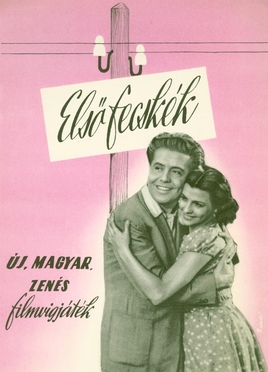Kamill Feleki | |
|---|---|
 Feleki in the 1930s | |
| Born | 21 August 1908 |
| Died | 18 October 1993 |
| Occupation | Actor |
| Years active | 1936–1990 (film & TV) |
Kamill Feleki (1908–1993) was a Hungarian film, stage and television actor. [1] [2]
Kamill Feleki | |
|---|---|
 Feleki in the 1930s | |
| Born | 21 August 1908 |
| Died | 18 October 1993 |
| Occupation | Actor |
| Years active | 1936–1990 (film & TV) |
Kamill Feleki (1908–1993) was a Hungarian film, stage and television actor. [1] [2]

The Hungarian Revolution of 1956, also known as the Hungarian Uprising, was an attempted countrywide revolution against the government of the Hungarian People's Republic (1949–1989) and the policies caused by the government's subordination to the Soviet Union (USSR). The uprising lasted 12 days before being crushed by Soviet tanks and troops on 4 November 1956. Thousands were killed and wounded and nearly a quarter of a million Hungarians fled the country.

Comparative literature studies is an academic field dealing with the study of literature and cultural expression across linguistic, national, geographic, and disciplinary boundaries. Comparative literature "performs a role similar to that of the study of international relations but works with languages and artistic traditions, so as to understand cultures 'from the inside'". While most frequently practised with works of different languages, comparative literature may also be performed on works of the same language if the works originate from different nations or cultures in which that language is spoken.

Sir Lewis Bernstein Namier was a British historian of Polish-Jewish background. His best-known works were The Structure of Politics at the Accession of George III (1929), England in the Age of the American Revolution (1930) and the History of Parliament series he edited later in his life with John Brooke.

Karl Paul Polanyi was an Austro-Hungarian economic anthropologist, economic sociologist, and politician, best known for his book The Great Transformation, which questions the conceptual validity of self-regulating markets.
Filmer Stuart Cuckow Northrop was an American legal philosopher and influential comparative philosopher.
Walter Fitzwilliam Starkie CMG, CBE, Litt.D was an Irish scholar, Hispanist, writer, and musician. His reputation is principally based on his popular travel writing: Raggle-Taggle (1933), Spanish Raggle-Taggle (1934) and Don Gypsy (1936).

German Hungarians are the ethnic German minority of Hungary, sometimes also called Danube Swabians, many of whom call themselves "Shwoveh" in their own Swabian dialect. There are 131,951 German speakers in Hungary. Danube Swabian is a collective term for a number of German ethnic groups who lived in the former Kingdom of Hungary, including the Kingdom of Croatia-Slavonia and Vojvodina. Other ethnic German groups previously lived on the territory of both the former Hungarian kingdom as well as on the territory of present-day Hungary since the Middle Ages onwards, most notably in Budapest but not only.

Sir John Rankine Goody was an English social anthropologist. He was a prominent lecturer at Cambridge University, and was William Wyse Professor of Social Anthropology from 1973 to 1984.

The Faculty of Humanities and Social Sciences or the Faculty of Philosophy in Zagreb is one of the faculties of the University of Zagreb.
Patrick Edward de Josselin de Jong was a professor of cultural anthropology at the University of Leiden for over 30 years, and department chair from 1957 through 1987. His research specialization was on the Minangkabau in West Sumatra.

The State Department Store is a 1953 Hungarian musical comedy film directed by Viktor Gertler and starring Miklós Gábor, Kálmán Latabár and Kamill Feleki. The film is set in and around a Budapest department store, whose employees are battling against black marketeers.
Conference on Latin American History, (CLAH), founded in 1926, is the professional organization of Latin American historians affiliated with the American Historical Association. It publishes the journal The Hispanic American Historical Review.

Tales Of Budapest is a 1937 Hungarian comedy film directed by Béla Gaál and starring Ida Turay, Antal Páger and Gyula Kabos. It was shot at the Hunnia Studios in Budapest. The film's sets were designed by the art director Márton Vincze.
Shigemi Inaga is a Japanese scholar in comparative literature, culture, and the history of cultural exchange.
The Siege of Beszterce is a 1948 Hungarian historical drama film directed by Márton Keleti and starring Klári Tolnay, Ida Turay and Andor Ajtay. It was based on the novel of the same title by Kálmán Mikszáth. It was shot at the Hunnia Studios in Budapest. The film's sets were designed by the art director Mátyás Varga.
Barnabás Hegyi (1914–1966) was a Hungarian cinematographer. He worked on around a hundred films, beginning his career in the Horthy era and continuing into post-war Communist Hungary. He is noted for his cinematography on the 1948 film Somewhere in Europe.

The Football Star is a 1957 Hungarian sports comedy film directed by Márton Keleti and starring Imre Pongracz as the football star, Kamill Feleki, László Ungváry and Manyi Kiss. It features a number of cameos from Ferenc Puskás and other footballers of the Hungarian national Golden Team, who had finished as runners-up at the 1954 World Cup. It was shot at the Hunnia Studios in Budapest. The film's sets were designed by the art director Zoltán Fülöp.

You Are the Song is a 1940 Hungarian drama film directed by Endre Rodríguez and starring János Sárdy, Imre Toronyi and Piroska Vaszary. It was shot at the Hunnia Studios in Budapest. The film's sets were designed by the art director József Simoncsics.

The First Swallows is a 1953 Hungarian comedy film directed by Frigyes Bán and starring József Juhász, Sándor Tompa and István Rozsos. It was shot at the Hunnia Studios in Budapest. The film's sets were designed by the art director Imre Sörés.

The Perfect Family is a 1942 Hungarian comedy film directed by László Sipos and starring Lili Muráti, Piroska Vaszary and Miklós Hajmássy. It was shot at the Hunnia Studios in Budapest. The film's sets were designed by the art director János Pagonyi.